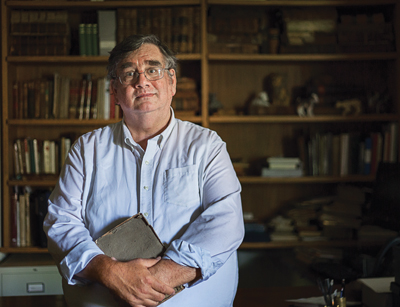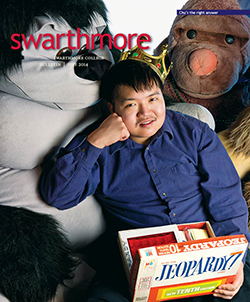Keeper of the Quaker Flame
Whether you’re seeking Elias Hicks’ death mask or Quaker meeting records, Christopher Densmore is a Friend indeed

Christopher Densmore on his title: “An archivist is the general professional term for people who work with the preservation of historical records with long-term value. Curators usually curate a museum or an art gallery. Why this position is called curator, I’m not entirely sure. By profession, I’m an archivist. That’s my self-identification.” Photo by Laurence Kesterson
Step into the office of Christopher Densmore, and you’ll encounter the sublime and the ridiculous. Sublime would be A Peaceable Kingdom, a painting by Edward Hicks that hangs across from Densmore’s desk in Friends Historical Library.
Ridiculous is the adjacent wax bust of Whittier Friends Church member Richard Nixon, acquired from a professor at the State University of New York at Buffalo. Before joining Friends Historical Library as curator in 2001, Densmore was the archivist there. A native Ohioan who has attended Friends meetings for the last 45 years, he is interested in all things Quaker. Bulletin editor Sherri Kimmel took a peek into Densmore’s dusty world this spring. Following is an edited transcript of their conversation.
What are some of the holdings in Friends Historical Library that can’t be found elsewhere?
Probably the most important part of our collection is the records of Quaker meetings and Quaker organizations. We have all the archival records for New York Yearly Meeting, the majority of records for Baltimore Yearly Meeting, and what used to be Virginia Yearly Meeting and Philadelphia Yearly Meeting. Quakers were involved in all kinds of things—religious dissent, religious toleration, women’s speaking, anti-slavery, Native American relations, attempts to settle conflicts by nonviolent means. They’re all through the thread of American history. And this stuff exists nowhere else. Now some of it’s been filmed, and you could look at the microfilm in other places. We’re currently working with Ancestry.com to digitize and make available a lot of stuff that would go onto Ancestry. They’re interested in it for its genealogical purpose.
What is the most surprising or unusual artifact in the collection?
We try to stay away from objects for the most part, because we don’t have a museum to directly display them. But for the past 140-odd years, we’ve gathered lots of things. Paintings are a special case. The College has two copies of The Peaceable Kingdom by Edward Hicks. To us, that’s not a piece of American folk art; it is a document of Quaker sensibilities. That’s why we have it. So that’s the high end of things. We also have a collection called relics, down at the very base of our operation in cabinets. One entry says spinning wheel. From the location, I know it’s in a cabinet where the shelves are about 8 inches apart. I can’t believe that somebody’s actually shoved an entire spinning wheel into a little shelf. So I go down there, and there’s a little wooden box. The top slides off, and you pull out some cotton packing material. Out comes a little carved model of a spinning jenny. The Industrial Revolution had a lot to do with mechanizing the production of cloth. So that in itself is interesting. But it’s carved in such a way that there are two women running the machine, and the wheels go around, and the women go from side to side.
It was carved by a French sailor—a prisoner of war—captured by the British during the Napoleonic Wars. We have it because there was an American Quaker, Stephen Grellet, who stopped to see the prisoners, and they’re the ones who gave him this little thing as a souvenir, and eventually we got it.
How old is it?
Between 1812 and 1815.
Do you seek out particular items for the collection? How? Through Ebay? Auctions?
We do all of that. Recently, diaries and letters of Priscilla Hunn Jenkins, a Quaker traveling minister who lived in southern Delaware, came to our attention from a book dealer. It turned out to be a reasonable price [FHL paid about $12,000]. It was steep for us, but it fit a hole. We have some endowed money that we can pull from.
You have an acquisitions budget?
We have a regular acquisitions budget, but it’s fairly small. Most of the materials we buy come out of endowed funds to support the purchase of manuscripts.
In this sesquicentennial year of the College, are there some special things going on at the FHL?
As you see as you walk in, there’s the big exhibit on the history of Swarthmore College. If you look at the [recently published] book [Swarthmore College: A Community of Purpose] on the history of the College, most of the historical documents are in the custody of Friends Library. We also talk to people on aspects of College history—what actually happened, and in some cases, we take a stab at what they actually meant. The College was coed. What’s important about that in its time and place? Allison Dorsey [professor of history] is doing a class [this fall] on the takeover of Parrish in 1969. We’ll probably see her students here scanning and making databases of newspaper accounts. So much of what we do is just facilitating, but we’re facilitating on a level that often involves us making interpretive and contextual comments about things.
You get many visitors to FHL. How many, and where are they from?
People come from pretty much all over the world—especially Europe. About the only fairly regular Asian visitors are Japanese. We probably had at least 30 visitors between Monday and Wednesday this week, all from places in the United States. A fair number were doing family history. But there’s a graduate student from a prestigious institution who’s looking into pacifism during the Civil War. There’s somebody who’s been here fairly often who’s studying an African-American woman in Philadelphia who was a Quaker in the early 20th century.
In the last few years, you’ve had some unusual visitors—celebrities. Tell me a little bit about that.
We’ve been on History Detectives. We’ve been on the Skip Gates program Finding Your Roots.
The latter dealt with Kevin Bacon’s Quaker ancestors?
Yes. They were looking for one of his ancestors whose name wasn’t Bacon, who had been involved with teaching freemen during the Civil War and after, and they wanted copies of certain documents and transcriptions and other information. I got interviewed for that but wasn’t actually in the room with Kevin Bacon. I had certain things I wanted to say, not necessarily in their script, which got left in. It gets some good publicity for Swarthmore College. We’re interested in people knowing about Quaker history, and they do a decent job with it.
But you did have another celebrity in recently—for Who Do You Think You Are? I’m sure it was a hardship to host Zooey Deschanel.
Well, we did a fair amount of research on that project, and then there was the whole day of shooting. We basically had to shut the door for that day. Pretty much all this was a surprise to her. She had heard vague family stories that [her] people were involved with anti-slavery activities. She seemed to be extremely pleased with what she found out: “Oh my God, they really were involved in the Underground Railroad. They really did stand off the federal marshals [in Christiana, Pa.] in 1851.”
So is it fun to deal with these programs and celebrities?
It’s fun. But the end consumer of all this research is not the academics who are writing the books. It’s got to go out to the general public. The number of people who are going to read four thick books on the [Christiana] resistance is small. The number of people who are going to learn something about it by seeing this television program is immense.
They’re drawn to the celebrity, and then they learn something.
Right. It’s a way of getting your message across, and we’re interested in people getting a good, accurate image. I’m glad it happens, but once a year is enough.
So do you have other personal effects of notable Quakers here?
Oh, we’ve got bits and pieces of things. We have a brooch that was given to Lucretia Mott. We have Lucretia Mott’s rocking chair and her tombstone, which has been replaced. She’s not without a tombstone.
You have some bonnets, right?
We have some bonnets. We have a piece of William Penn’s trunk and a piece of the tree that George Fox preached under when he was on Long Island in 1672. There are lots of little things.
Are you a collector in your private life?
I kind of accumulate things. I guess the overall sense is that our house is full of old junk.
 Email This Page
Email This Page